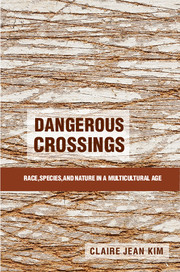9 - We Are All Animals/We Are Not Animals
Published online by Cambridge University Press: 05 April 2015
Summary
Impassioned disputes over the animal practices of racialized others open a window onto the synergistic workings of the taxonomies of race and species in the contemporary United States. Historically conjoined, the two logics continue to sustain and energize one another in the joint project of producing the human and the subhuman, not-human, less than human – with all of the entailments of moral considerability, physical vulnerability, and grievability that follow. The live animal market, whaling, and dogfighting conflicts discussed here appear at first glance to be zero-sum games, compelling us to choose between the interests and needs of racialized humans and the interests and needs of nonhuman animals. But this is a false choice, I have argued. In fact, the ultimate fates of these two groups of beings are irretrievably caught up together in the skein of power that traverses and binds the taxonomies of race and species.
In 2005, People for the Ethical Treatment of Animals (PETA) launched a traveling exhibit entitled Animal Liberation Project: We Are All Animals. Following on the heels of an earlier PETA exhibit that had likened modern industrial farming to the Holocaust, this one featured oversized panels juxtaposing images of the violence done to animals in industrial farming, scientific research, and the circus with the violence done to marginalized human others (slaves, lynching victims, subjects of the Tuskegee syphilis experiments, displaced Native Americans, force-fed suffragettes, and more) throughout U.S. history. Reactions were quick and fierce across the board, with Black civil rights leaders and the mainstream media alike excoriating the exhibit as racist, offensive, and outrageous (Kim 2011). In an official apology, PETA’s president Ingrid Newkirk argued that the exhibit did not use the association of animals and nonwhites to denigrate the latter, but rather to uplift animals. The point of the exhibit, she claimed, was to expose the “might makes right” thinking underlying both types of oppression and to show how both groups have been seen as “deficient and thus disposable” (Newkirk 2005). As criticism persisted, Newkirk shut down the traveling exhibit but placed a virtual version of it on the organization’s Web site, where it has gone through various iterations in the years since.
- Type
- Chapter
- Information
- Dangerous CrossingsRace, Species, and Nature in a Multicultural Age, pp. 283 - 288Publisher: Cambridge University PressPrint publication year: 2015

